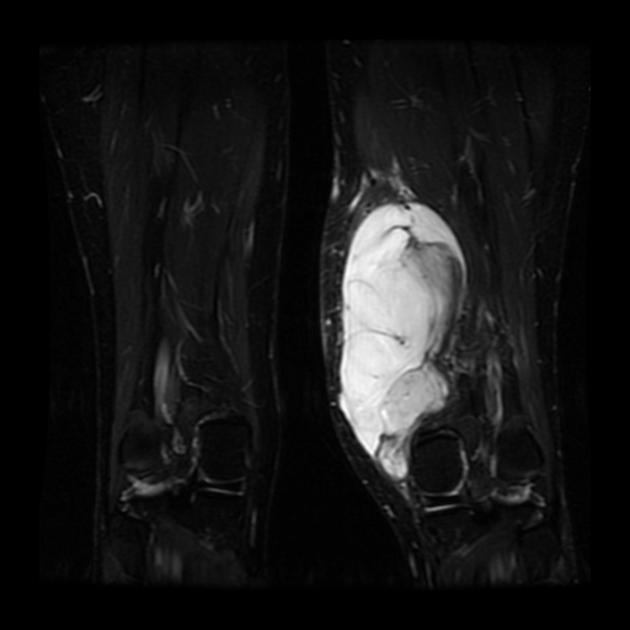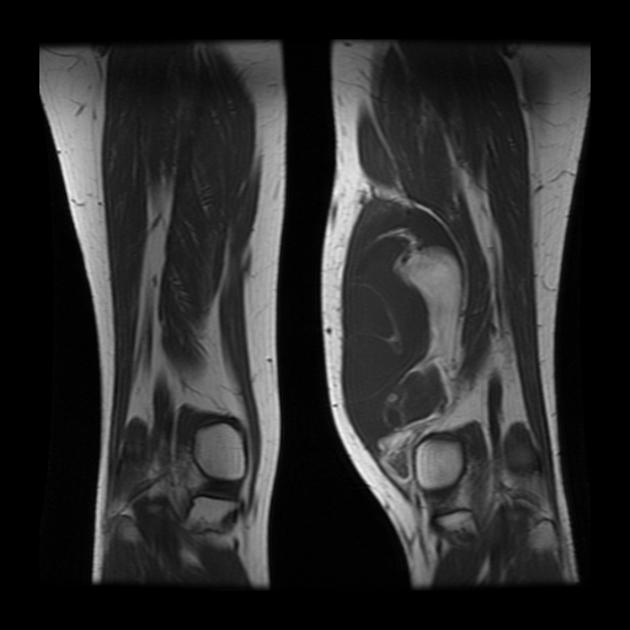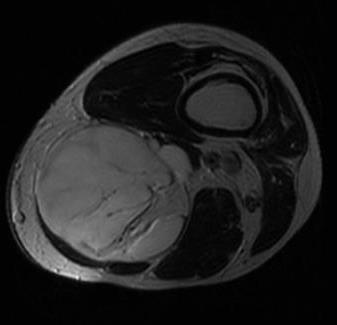Liposarcoma MRI
Jump to navigation
Jump to search
|
Liposarcoma Microchapters |
|
Diagnosis |
|---|
|
Treatment |
|
Case Studies |
|
Liposarcoma MRI On the Web |
|
American Roentgen Ray Society Images of Liposarcoma MRI |
Editor-In-Chief: C. Michael Gibson, M.S., M.D. [1]; Associate Editor(s)-in-Chief: Alejandro Lemor, M.D. [2]
Overview
MRI is the optimal imaging test for the diagnosis of liposarcoma. MRI findings for a well-differentiated liposarcoma include a mass with at least 75% of adipose content with thin irregular septa. MRI also evaluates the size, location, and depth of the mass. MRI findings help to differentiate between the different sub-types of liposarcoma and also help to assess distant metastasis.
MRI
- MRI findings for a well-differentiated liposarcoma include a mass with at least 75% of adipose content with thin irregular septa.[1]
- Other sub-types may demonstrate fewer adipose content.
- Thick septa inside the mass are associated with a malignant disease and poorer prognosis.
- Hemorrhage and necrosis may be observed within the mass among patients with the de-differentiated sub-type of liposarcoma.
- Typically, myxoid liposarcoma has a low signal intensity on T1, in contrast to well-differentiated liposarcoma which has a high intensity signal on T1 due to the presence of high adipose content.[2]
- The myxoid sub-type may be associated with a cystic appearance on MRI among approximately 20% of cases. The myxoid sub-type may also appear multilobulated. [3]
Images
 Image courtesy of Radiopaedia.org |
 Image courtesy of Radiopaedia.org |
 Image courtesy of Radiopaedia.org |
References
- ↑ Peterson, Jeffrey J.; Kransdorf, Mark J.; Bancroft, Laura W.; O'Connor, Mary I. (2003). "Malignant fatty tumors: classification, clinical course, imaging appearance and treatment". Skeletal Radiology. 32 (9): 493–503. doi:10.1007/s00256-003-0647-8. ISSN 0364-2348.
- ↑ M. S. Sung, H. S. Kang, J. S. Suh, J. H. Lee, J. M. Park, J. Y. Kim & H. G. Lee (2000). "Myxoid liposarcoma: appearance at MR imaging with histologic correlation". Radiographics : a review publication of the Radiological Society of North America, Inc. 20 (4): 1007–1019. doi:10.1148/radiographics.20.4.g00jl021007. PMID 10903690. Unknown parameter
|month=ignored (help) - ↑ M. S. Sung, H. S. Kang, J. S. Suh, J. H. Lee, J. M. Park, J. Y. Kim & H. G. Lee (2000). "Myxoid liposarcoma: appearance at MR imaging with histologic correlation". Radiographics : a review publication of the Radiological Society of North America, Inc. 20 (4): 1007–1019. doi:10.1148/radiographics.20.4.g00jl021007. PMID 10903690. Unknown parameter
|month=ignored (help)